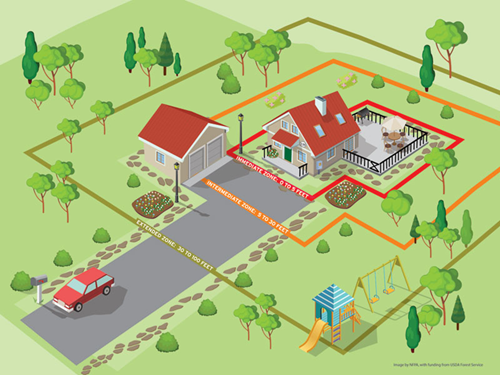Home Ignition Zones and Defensible Space
Creating and maintaining defensible space is crucial to improve your home’s chance of surviving a wildfire event. This is the buffer you create between a structure on your property and the grass, trees, shrubs, or wildland areas that surround it. This space, when maintained properly, will slow or stop the spread of wildfire and protects your home from catching fire. Defensible space is also important for the protection of the firefighters defending your home.
The concept of the home ignition zone was developed by retired USDA Forest Service fire scientist Jack Cohen in the late 1990s, following some breakthrough experimental research into how homes ignite due to the effects of radiant heat. The Home Ignition Zone (HIZ) is divided into three zones.

Immediate Zone
The immediate zone consists of the home itself and the area 0-5 feet from the furthest attached point of the home. This should be a non-combustible area void of flammable materials.
- Remove all flammables—plants, propane tanks, firewood piles, materials—from wall exteriors. Remove anything stored underneath decks and porches that can burn.
- Repair or replace damaged window screens or broken windows.
- Protect overhangs and attachments by removing fuels from the area and covering any openings.
- Be embers aware. Look for receptive fuel beds or places on your home where embers can land.
- Clean roofs and gutters of debris that could catch embers.
- Replace or repair any loose or missing roof shingles or tiles to prevent ember penetration.
- Install metal mesh screening 1/8-inch opening or smaller over attic vents or those found in eaves, fascias, or soffits to block ember intrusion.
Intermediate Zone
The intermediate zone is the area 5-30 feet from the furthest exterior point of the home. Within this area, careful landscaping and creating breaks in the vegetation can help influence and decrease fire behavior.
- Clear vegetation from any outbuildings, propane tanks, or other infrastructure in this area.
- Keep lawns ‘lean, clean, and green’.
- Remove ladder fuels, or vegetation under trees) so that a surface fire cannot reach tree crowns. Prune trees up to 6 feet from the ground. For shorter trees, trim branches so they do not touch the ground but do not exceed 1/3 of the overall tree height.
- Create space between trees and tree crowns.
- Break the continuity of fuel across the landscape in this zone. Limit vegetation to small clusters of trees or shrubs and create fuel breaks with flower beds, driveways, or walkways/paths.
Extended Zone
The extended zone is the area 30-100 feet, out to 200 feet from the furthest exterior point of the home. This area should interrupt the fire’s path and keep flames small and on the ground.
- Clear vegetation from any outbuildings, propane tanks, or other infrastructure in this area.
- Remove heavy accumulation of litter and debris.
- Remove dead or decaying plant and tree material.
- Remove smaller conifers growing between mature trees.
- Reduce the density of taller trees.
Check out this video from the Holcombe Road Fire in 2020. The home survived due to homeowner actions and creating defensible space.
For more information, visit NFPA’s Preparing Homes for Wildfire website: https://www.nfpa.org/Public-Education/Fire-causes-and-risks/Wildfire/Preparing-homes-for-wildfire
Improving Access for Emergency Responders
A quick response to a wildfire is critical for saving your home. Firefighting personnel must be able to quickly locate and safely travel to your home. Emergency responders may not be familiar with your community, so highly visible signs are important to help them find their way.
You must also remember that fire trucks are larger and heavier than normal vehicles, it is essential that all access lanes are wide enough, have proper clearance and can support the weight of fire vehicles. Here are a few tips to help improve access to your property:
Street Signs
- At least 3-inches tall
- Words on a contrasting color background
- Made of reflective material
- Made of fire-resistant material
- Visible from both directions
Addresses
- Streets should be labeled, having different names and numbers.
- Your home should have its own house number and be in numerical order along your street.
- If your home is set back from the street, post your address at the end of your driveway where it is visible from the street.
- If multiple homes share a single driveway, post all addresses at the entrance from the street and at each appropriate intersection along the driveway.
Roads
- Single lane one-way roads should have turnout spaces at regular intervals to allow emergency vehicles access and cars to pass.
- Design a minimum of two primary roads in every development.
- Public and private streets should be a minimum of 10 feet wide, in order to allow two traffic lanes.
- Curves and intersections should be wide enough for large fire equipment to easily pass and turn.
- Streets and bridges should be built to withstand at least 40,000 pounds
- Roads and driveways must not be too steep or have sharp curves.
- Dead end streets and long driveways should have a turnaround area designed as a T or circle large enough to allow emergency equipment to turn around.
Whether you live in a community with poorly labeled streets or at the end of a long dead end road, making sure emergency personnel can quickly locate and get to your home can increase your home’s chance of survival during a wildfire.